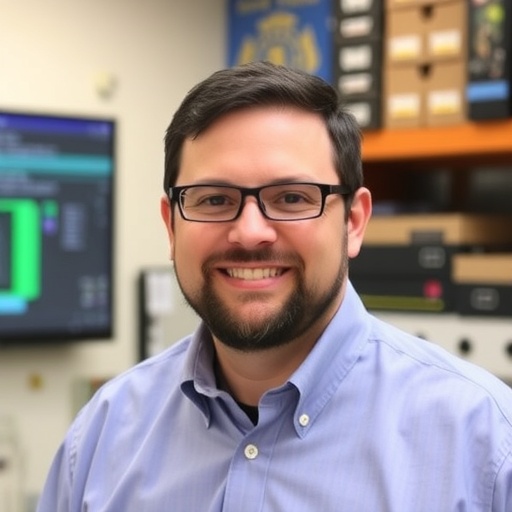
Kennesaw State University physicist Andreas Papaefstathiou has secured a prestigious three-year grant of $799,651 awarded by the U.S. Department of Energy (DOE) to advance the theoretical understanding of nuclear matter by investigating collisions of subatomic particles at extremely high energies. This grant positions KSU at the forefront of particle physics research related to nuclear collisions and underscores the institution’s growing role in shaping data interpretation strategies for upcoming national experimental facilities.
The core ambition of Papaefstathiou’s project hinges on enhancing computer simulations that model the interactions occurring within particle colliders, particularly focusing on nuclear collisions. These collisions, occurring at relativistic speeds, present immense complexity where quarks and gluons—the fundamental constituents of matter—interact in phases theorized but not yet fully understood. His work aims to unravel these complexities by refining computational frameworks which can faithfully simulate these high-energy events.
Central to Papaefstathiou’s methodology is the use of Monte Carlo event generators, a sophisticated class of computational algorithms rooted in theoretical physics. These generators simulate particle collision events probabilistically, producing detailed predictions about particle behavior and interaction outcomes within colliders. Papaefstathiou contributes extensively to the development of HERWIG, a premier Monte Carlo event generator widely used within the particle physics community, empowering KSU students to engage with cutting-edge computational tools.
.adsslot_5GfgE2YMc1{width:728px !important;height:90px !important;}
@media(max-width:1199px){ .adsslot_5GfgE2YMc1{width:468px !important;height:60px !important;}
}
@media(max-width:767px){ .adsslot_5GfgE2YMc1{width:320px !important;height:50px !important;}
}
ADVERTISEMENT
The upcoming Electron Ion Collider (EIC) at Brookhaven National Laboratory represents a pivotal experimental platform, aiming to collide polarized electrons with protons and ions at unprecedented precision. Papaefstathiou’s simulations will provide vital theoretical insights and predictive capabilities indispensable for interpreting the EIC’s experimental data, potentially unlocking new physics beyond the Standard Model. His research, therefore, serves as a critical theoretical pillar in this national scientific endeavor.
Kennesaw State University’s investment in research infrastructure, notably through its Center for Research Computing and Department of Physics computational resources, plays a crucial role in enabling Papaefstathiou’s work. The high-performance computing facilities support the demanding calculations required for simulating particle collisions, allowing for increasingly precise models that can incorporate complex quantum chromodynamics phenomena.
This DOE grant augments a continuum of federal support, building upon a four-year, $147,000 National Science Foundation (NSF) grant that Papaefstathiou currently holds to study Higgs boson properties and search for novel phenomena in collider physics. The synergy between the NSF and DOE funding fosters a comprehensive research pipeline from theory to phenomenology, further solidifying KSU’s prominence in particle physics research.
Collaborations between academic institutions strengthen the project’s intellectual breadth, with co-principal investigator Yang-Ting Chien of Georgia State University lending expertise in theoretical nuclear physics models. This partnership exemplifies the increasingly interdisciplinary and inter-institutional nature of advanced particle physics research, linking analytic theory, computational modeling, and experimental frameworks.
Papaefstathiou’s work arrives at a moment when nuclear and particle physicists worldwide are gearing up to complement the Large Hadron Collider’s monumental discoveries with the EIC’s unique capabilities. The electron-ion collisions will illuminate the inner structure and spin dynamics of nucleons, thus addressing longstanding questions about how fundamental particles generate mass and other intrinsic properties. Theoretical modeling of these interactions is essential to decode the EIC’s experimental findings.
The research community at Kennesaw State is witnessing a surge of achievement across multiple projects and faculty endeavors, contributing to a vibrant and dynamic physics research culture. Other faculty members have secured significant grants for exploring theoretical physics at CERN and for investigating novel magnetic materials and quantum technologies, reflecting a multidisciplinary approach and broad scientific impact.
Undergraduate and graduate students at KSU are also taking advantage of these rich research opportunities. Students like Casey Hampson and Emily Manqueros have participated in prestigious summer research programs and symposiums, while Siam Sarower achieved national recognition by receiving the highly competitive Barry Goldwater Scholarship for his innovative work involving space-time modulation in graphene. These accomplishments underscore the university’s role in cultivating the next generation of scientific leaders.
Papaefstathiou’s emphasis on Monte Carlo event generators is especially notable because these tools bridge the gap between abstract theoretical constructs and tangible experimental predictions. Their development requires deep insight into both quantum field theory and numerical techniques, combining physics with computer science. As these generators improve, they enable more accurate simulations of particle showers, hadronization processes, and decay channels that experiments observe.
Looking forward, the data emerging from the upcoming Electron Ion Collider will rely extensively on the refined computational frameworks that researchers like Papaefstathiou are perfecting. His foundational work ensures that U.S.-based physicists remain competitive and proactive in elucidating the subatomic fabric of matter, potentially leading to paradigm shifts in our understanding of the strong nuclear force and beyond.
With rising federal investment and institutional support, the momentum at KSU’s Department of Physics is emblematic of a broader revitalization within American particle physics research. Groundbreaking studies and continued grant successes indicate that the university is rapidly becoming a hub for innovative theoretical and computational physics, bridging global experimental initiatives with homegrown intellectual rigor.
By deeply integrating theoretical modeling with experimental anticipation, the research spearheaded by Papaefstathiou represents a vital link in the chain of modern physics discovery. It will help decode the mysteries of nuclear matter at the most fundamental level, enhance interpretive clarity of experimental results, and foster a collaborative ecosystem across universities and national laboratories.
Subject of Research: Theoretical particle physics focusing on nuclear matter and particle collisions using Monte Carlo event generators.
Article Title: Kennesaw State Physicist Secures DOE Grant to Illuminate Nuclear Matter via Advanced Computational Models
News Publication Date: August 2024
Web References:
– https://www.kennesaw.edu/csm/
– https://www.kennesaw.edu/research/centers-facilities/center-research-computing/
– https://www.kennesaw.edu/news/stories/2024/physics-professors-continue-study-of-elementary-particles.php
– https://www.kennesaw.edu/news/stories/2024/physics-major-to-spend-summer-at-cern.php
Image Credits: Credit: Kennesaw State University
Keywords
Particle physics, nuclear matter, Monte Carlo event generators, HERWIG, Electron Ion Collider, theoretical physics, computer modeling, nuclear collisions, Higgs boson, high-energy physics, computational simulations, particle collider experiments
Tags: computational frameworks in physicsHERWIG Monte Carlo generatorhigh-energy physics researchKennesaw State University physics researchMonte Carlo event generatorsnuclear matter theoretical understandingparticle collider simulationsparticle physics education at KSUquarks and gluons interactionsrelativistic nuclear collisionssubatomic particle collisionsU.S. Department of Energy grant





